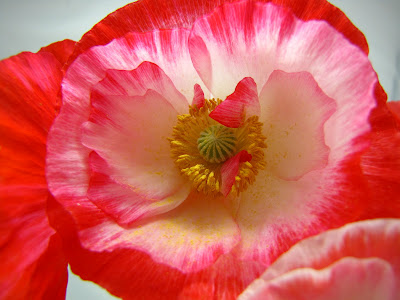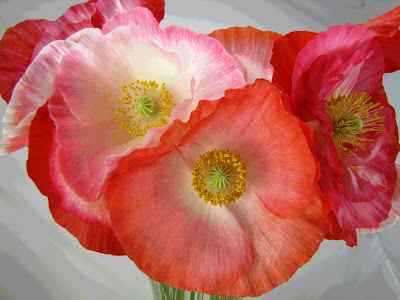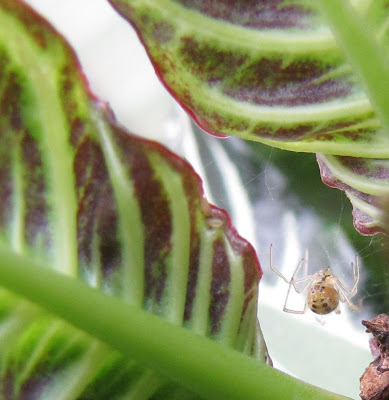 The photo above was very amenable to tight cropping - I especially love how the tiny little hole in the petal is placed.
The photo above was very amenable to tight cropping - I especially love how the tiny little hole in the petal is placed.
Dear Spring Garden, I love you
6 hours ago
Beta Tauri is a star in the constellation of Taurus and is the tip of one of the bull's horns. As a Taurus, I personify the qualities traditionally attributed to the sign: stubborn, loyal, and constantly striving to create things of beauty through gardening, photography and fiber arts. All photographs by the Blog Author, unless indicated.




 In the early spring our front yard is blessed with a carpet of fuchsia/pink and white cyclamen flowers. Last year, I spent hours and hours photographing them to obtain a small batch of photos I was very pleased with. Thus, I thought I was pretty on top of the cyclamen population.
In the early spring our front yard is blessed with a carpet of fuchsia/pink and white cyclamen flowers. Last year, I spent hours and hours photographing them to obtain a small batch of photos I was very pleased with. Thus, I thought I was pretty on top of the cyclamen population.  Imagine my surprise when I found this speckled, purple and white specimen behind our garbage can. It was the day before garbage pick-up, and I was in the process of cramming all the yard waste I could into the can when I saw this one tiny flower.
Imagine my surprise when I found this speckled, purple and white specimen behind our garbage can. It was the day before garbage pick-up, and I was in the process of cramming all the yard waste I could into the can when I saw this one tiny flower.  A Google search of "variegated cyclamen" yielded some very good examples, but nothing quite like this flower. A genetic freak, perhaps?
A Google search of "variegated cyclamen" yielded some very good examples, but nothing quite like this flower. A genetic freak, perhaps?

 The dead leaf was found hanging on the side of a tree that had recently been scorched by fire - it is fair to say this is a "crime scene photo". Our neighbors insist on burning copious amounts of yard waste in their back yard - despite the danger inherent in doing so during the usually dry summer and in violation of city law. Our neighbor's behavior has inspired The Boyfriend to take up the mantle of "Neighborhood Asshole" - a role that had recently been played by our next door neighbor until his untimely death by cancer. Considering our neighborhood is a tinderbox of dry pine needles...I can't say that I blame him. Needless to say, I took some more comprehensive "crime scene" photos.
The dead leaf was found hanging on the side of a tree that had recently been scorched by fire - it is fair to say this is a "crime scene photo". Our neighbors insist on burning copious amounts of yard waste in their back yard - despite the danger inherent in doing so during the usually dry summer and in violation of city law. Our neighbor's behavior has inspired The Boyfriend to take up the mantle of "Neighborhood Asshole" - a role that had recently been played by our next door neighbor until his untimely death by cancer. Considering our neighborhood is a tinderbox of dry pine needles...I can't say that I blame him. Needless to say, I took some more comprehensive "crime scene" photos.
 Above: a busy bee hard at work, unaware I've got him in my sights. Clearly, they did not get the memo that Sunday is a day to kick back. If the bee saw my photo, I wonder if he would say: "Does this flower make my butt look big?"
Above: a busy bee hard at work, unaware I've got him in my sights. Clearly, they did not get the memo that Sunday is a day to kick back. If the bee saw my photo, I wonder if he would say: "Does this flower make my butt look big?" Above: while it looks like the bee is laying down on the job and slacking off, he is really working all six legs! He looks like he's running in place as he gathers pollen.
Above: while it looks like the bee is laying down on the job and slacking off, he is really working all six legs! He looks like he's running in place as he gathers pollen. Above: "Who IS this chick with the friggin' camera????? I'm outta here!"
Above: "Who IS this chick with the friggin' camera????? I'm outta here!"
 Above: Yellow Aquilegia, common name Columbine - rescued from my local K-Mart. The darkish spot where it is planted provides some nice light/shadow contrast - very chiaroscuro!
Above: Yellow Aquilegia, common name Columbine - rescued from my local K-Mart. The darkish spot where it is planted provides some nice light/shadow contrast - very chiaroscuro! Above: Current Lakewood Manor resident - light purple Columbine.
Above: Current Lakewood Manor resident - light purple Columbine. Above: Another current resident - maroon double bloom Columbine.
Above: Another current resident - maroon double bloom Columbine.


 Shirley Poppy flowers rest on slim, delicate stems - making them sway in the breeze. Which in turn results in photos that are a little too blurry. Since I wanted to cut several down for a bouquet, I decided to try out the lightbox and experiment with artificial light.
Shirley Poppy flowers rest on slim, delicate stems - making them sway in the breeze. Which in turn results in photos that are a little too blurry. Since I wanted to cut several down for a bouquet, I decided to try out the lightbox and experiment with artificial light. The two photos posted here are the best of the batch - I love how white and clean the light is. I used the "vibrant" color setting on the camera, and did some very simple photo editing using Microsoft Photo Editor to achieve a "painterly" effect (Photoshop will be entering my life soon - I have a feeling I'll be talking about my life in terms of "pre-Photoshop" or "post-Photoshop" once I open that Pandora's box). Bringing plant life into the house to photograph in the lightbox has been in the back of my mind for a while, and this is the first time I have done it. I am thrilled with the results, and am looking forward to dragging all manner of plant materials into the house this winter for the lightbox treatment.
The two photos posted here are the best of the batch - I love how white and clean the light is. I used the "vibrant" color setting on the camera, and did some very simple photo editing using Microsoft Photo Editor to achieve a "painterly" effect (Photoshop will be entering my life soon - I have a feeling I'll be talking about my life in terms of "pre-Photoshop" or "post-Photoshop" once I open that Pandora's box). Bringing plant life into the house to photograph in the lightbox has been in the back of my mind for a while, and this is the first time I have done it. I am thrilled with the results, and am looking forward to dragging all manner of plant materials into the house this winter for the lightbox treatment.


 Above: Sedum spurium (aka "John Creech Sedum") flower
Above: Sedum spurium (aka "John Creech Sedum") flower Above: Sempervivum tectorum (aka "Hens and Chicks") flower
Above: Sempervivum tectorum (aka "Hens and Chicks") flower Above: Close up of Sempervivum tectorum flower
Above: Close up of Sempervivum tectorum flower Above: Sedum album (aka "Chubby Fingers") flower
Above: Sedum album (aka "Chubby Fingers") flower
 The Shirley Poppies pictured here were photographed from underneath on a brilliant, sunny day - makes you want to stretch for the sun!
The Shirley Poppies pictured here were photographed from underneath on a brilliant, sunny day - makes you want to stretch for the sun!
 Above: Unidentified spider hard at work on my Zebra plant
Above: Unidentified spider hard at work on my Zebra plant Above: At this point, the spider got pretty shy; I'm just pointing my camera lens at it and hoping for the best
Above: At this point, the spider got pretty shy; I'm just pointing my camera lens at it and hoping for the best Above: Follow the light little spider, follow the light
Above: Follow the light little spider, follow the light Above: Reliable volunteer snapdragon
Above: Reliable volunteer snapdragon Above: Reliable volunteer snapdragon aping Georgia O'Keefe
Above: Reliable volunteer snapdragon aping Georgia O'Keefe Above: A decidedly non-volunteer Shirley Poppy - the first of 2010
Above: A decidedly non-volunteer Shirley Poppy - the first of 2010 Above: flowers on my Allen Eureka Lemon (aka Meyer Lemon) tree
Above: flowers on my Allen Eureka Lemon (aka Meyer Lemon) tree Above: flowers on my Allen Eureka Lemon (aka Meyer Lemon) tree
Above: flowers on my Allen Eureka Lemon (aka Meyer Lemon) tree Above: flower from a Sedum reflexum, also known as Jenny's Stonecrop (my best guess based on internet research), showing no signs of wilt in 95 degree weather.
Above: flower from a Sedum reflexum, also known as Jenny's Stonecrop (my best guess based on internet research), showing no signs of wilt in 95 degree weather. 



 Another gray, drizzly summer day in the south end of Puget Sound. If we are lucky, we'll hit 68 degrees today. Having lived here for 20+ years, I should be used to it, along with the effort it takes to live as if the sun was out. Obviously - you can't have the lush green without the abundance of rain. Maybe I'm extra peeved because I recently spent countless hours trying to re-install an irrigation system in the garden - only to find that the garden won't need water for days. You just have to suck it up and be "Thankful for the Green".
Another gray, drizzly summer day in the south end of Puget Sound. If we are lucky, we'll hit 68 degrees today. Having lived here for 20+ years, I should be used to it, along with the effort it takes to live as if the sun was out. Obviously - you can't have the lush green without the abundance of rain. Maybe I'm extra peeved because I recently spent countless hours trying to re-install an irrigation system in the garden - only to find that the garden won't need water for days. You just have to suck it up and be "Thankful for the Green". (Above: a small section of the diverse plant life in our front yard.)
(Above: a small section of the diverse plant life in our front yard.) (Another section shown above).
(Another section shown above).